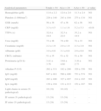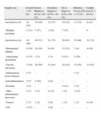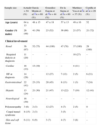The epidemiology of systemic amyloidosis has been changing in the last decades. We aim to describe the clinical characteristics of the patients seen at our institution with systemic amyloidosis in 2000–2010 and compare them with previous Spanish series.
Patients and methodsAn observational, retrospective study was performed on all the patients admitted to a tertiary hospital in Madrid, Spain who had been diagnosed of amyloidosis from January 2000 to December 2010. Patients without a proven diagnosis of amyloidosis, with dialysis-associated, senile, or localized forms of amyloidosis were excluded from the study. A systematic review was made of the clinical records, collecting the demographic, clinical and biochemical variables at diagnosis and patients’ outcome.
ResultsA total of 55 patients were studied, 24 (44%) of whom had AL amyloidosis, 30 (56%) AA amyloidosis, and 1 a familiar form. The most frequent underlying disorders were rheumatoid arthritis (9 patients, 30%) and ankylosing spondylitis (4 cases, 13%). The kidneys were the most frequently involved organ (36 patients, 67%) with nephrotic-range proteinuria during diagnosis (3.4±3.7g/24h). Median time to diagnosis was 3 months (interquartile range [IQR]: 1–17). Median follow-up time was 24 months (IQR: 10–91). During follow-up 31 patients died; 18 of those deaths were related to amyloidosis.
ConclusionsRenal dysfunction dominates the course of systemic amyloidosis, which does not seem to have changed in the last decades. We have observed an important delay in the diagnosis of these processes. Therefore, it is necessary to maintain a high degree of clinical suspicion regarding these conditions.
La epidemiología de las amiloidosis sistémicas está cambiando en las últimas décadas. Describimos las características clínicas de los pacientes con amiloidosis sistémicas atendidos en nuestro centro en el periodo 2000-2010 y las comparamos con las anteriores series españolas.
Pacientes y métodosEstudio observacional retrospectivo de pacientes con diagnóstico de amiloidosis sistémica en un hospital terciario entre enero de 2000 y diciembre de 2010. Se excluyó a los pacientes sin diagnóstico histológico y a aquellos con formas asociada a diálisis, seniles o localizadas. Mediante revisión sistemática de las historias clínicas se recogieron las variables demográficas, clínicas, de diagnóstico, seguimiento y mortalidad.
ResultadosSe estudió a 55 pacientes, 24 (44%) tenían amiloidosis AL, 30 (56%), amiloidosis AA y un paciente, una forma familiar. Las enfermedades inflamatorias subyacentes más frecuentes fueron la artritis reumatoide (9 pacientes, 30%) y la espondilitis anquilosante (4 enfermos, 13%). El órgano más frecuentemente afectado fue el riñón (36 pacientes, 67%), con una proteinuria al diagnóstico de 3,4±3,7g/24h. El tiempo hasta el diagnóstico fue de 3 meses (rango intercuartílico [RIC]: 1-17). La mediana de seguimiento fue de 24 meses (RIC: 10-94). Durante el seguimiento fallecieron 31 pacientes y 18 muertes fueron atribuíbles a la amiloidosis.
ConclusionesLa afectación renal es la presentación más prevalente de las amiloidosis sistémicas, sin cambios en las últimas décadas. Observamos un largo tiempo de latencia hasta el diagnóstico, por lo que es preciso mantener un alto grado de sospecha clínica de estos procesos.
Article
Diríjase desde aquí a la web de la >>>FESEMI<<< e inicie sesión mediante el formulario que se encuentra en la barra superior, pulsando sobre el candado.

Una vez autentificado, en la misma web de FESEMI, en el menú superior, elija la opción deseada.

>>>FESEMI<<<











